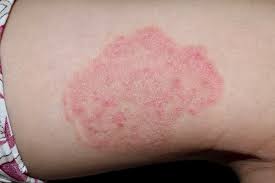
Superficial fungal infection of the skin commonly known as ringworm.
Annular plaque with a rim of scaly erythema most commonly seen on the torso of the elderly.
Typically involves the neck, trunk and extremities.
Erythematosus scaly patches with central clearing and elevated border ref2242ed to as ringworm.
Potassium hydroxide preparation establishes the diagnosis.
Refers to infections anywhere on the body except the scalp, feet, hands, beard, growing, or nails.
Most common offending dermatophyte is Trichophyton rubrum.
Co-infection is common involving the feet, hands, growing, and nails.
May present acutely and spread rapidly or as mild, chronic rash.
Infections are usually asymptomatic but can be pruritic.
Secondary infections or maceration may be associated with pain.
Transmission occurs from skin to skin contact or after exposure to infected fomites, including including shared clothing.
Associated with occlusive garments which can increase the risk.
Infected animals can transmit tinia zoonotic transmission.
Topical antifungal agent is the treatment.
Topical antifungal agents are usually sufficient to treat isolated, superficial plaques.
The main classes of topical antifungal’s include: allylamines and azoles which are fungistatic and prevent ergosterol synthesis in fungal membranes.
Both types of agents demonstrate low rates of adverse events and are efficacious.
Alternative agents include Butenafine, a fungistatic benzylamine and ciclopirox, a fungicidal agent.
Systemic treatment may be indicated with extensive inflammatory lesions, resistance to topical agents or hair or nail infection.
Preventive measures include adequate personal hygiene, keeping the skin dry, cool and avoiding occlusive garments.
